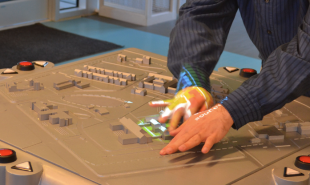
3D printing is proving a valuable tool for enhancing the experiences of visually-impaired and blind people. We have already seen The Tactile Picture Books Project – which creates textured 3D models of the illustrations in children’s books – and OwnPhone, a credit-sized device that enables visually-impaired people to call pre-selected numbers.
Now, Touch Graphics and the University of Buffalo’s Center for Inclusive Design and Environmental Access are using the technology to create interactive, talking models which can replace inadequate traditional paper maps at big institutions such as campuses and museums. So far, they have installed unique models at various institutions for the visually impaired in USA — the latest is the Talking Campus model at Perkins School for the Blind.
Visitors — both visually impaired and otherwise — can use the model to help orientate themselves by exploring its touch-sensitive surface. The model responds to pressure on different areas of its 3D surface with appropriate audio feedback including instructions, walking directions and the names of nearby buildings and staff. An overhead video projector “paints’” the monochromatic silver surface with light, bringing it to life visually — it can even project Google Earth aerial views.
The talking maps are useful for sighted users too, especially with the enhanced visual features, since they engage multiple senses in a way that can help users create a mental map of a complicated space. Heamchand Subryan, a researcher at IDEA Center, sees them being potential tools in malls, museums and campuses around the world. What other products could be made more accessible to the visually impaired by becoming multi-sensory?
Website: www.touchgraphics.com/research
Contact: info@touchgraphics.com




